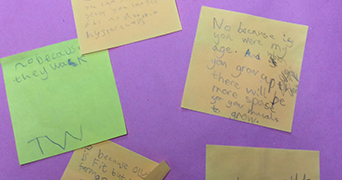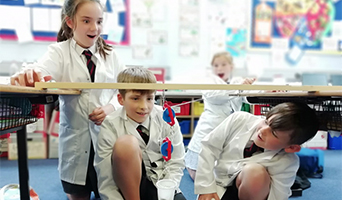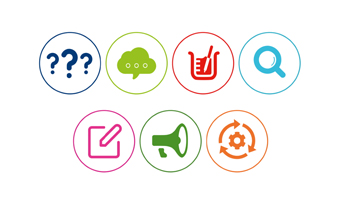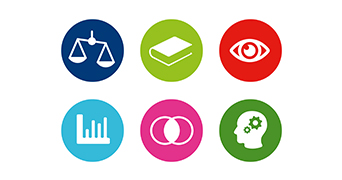
Floorbooks
Assessment, Science Enquiry, SEN(D) / Additional Support needs, Subject Leader Support
3-5, 5-7, 7-9, 9-12
Using floorbooks as a strategy for developing, recording, and assessing children's understanding of scientific concepts and practical science skills.
A floorbook is a large book for recording children’s science learning, individually and collaboratively. Floorbooks are used as a strategy for developing and assessing children’s understanding of science and can be used with any age group.
Floorbooks can include photographs, children’s comments, drawings, tables, graphs, annotated diagrams, classification keys and writing. Having a class record means it is easier to track changes in children’s ideas and understand how children are developing their understanding of science.
The original Floorbook CPD unit was developed by Kendra McMahon (Bath Spa University) and teacher Rhiannedd Baker in 2002. The unit has been revised in 2018 by PSTT Fellows Alison Trew and Caroline Skerry who both use floorbooks in their science lessons.
Why & How
What are the benefits of using floorbooks?
Floorbooks support teaching and children’s learning in science in many different ways depending on how you use them in your own setting. Download this guide to find out how to use a floorbook in your classroom.
Floorbooks Guide
We believe that using floorbooks in science promotes the development of children’s ideas, thinking and reasoning skills, models the collaborative nature of science and supports effective teacher assessment.

Examples of children's learning in Floorbooks
Why Use Floorbooks?
Assessment, Science Enquiry, SEN(D) / Additional Support needs, Subject Leader Support | 3-5, 5-7, 7-9, 9-12
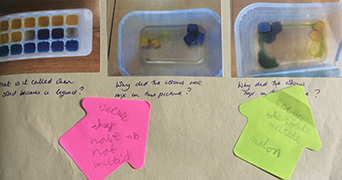
Examples of Types of Enquiry in Floorbooks
Assessment, Science Enquiry, Subject Leader Support
How To Use Floorbooks
Assessment, Science Enquiry, SEN(D) / Additional Support needs, Subject Leader Support
Working Scientifically Progression
Assessment, Science Enquiry, Subject Leader Support | 3-5, 5-7, 7-9
FAQs
Questions asked by teachers using floorbooks
Responding with interest to a child’s idea is important – even if you see it as ‘wrong’. If you dismiss or ignore a child’s response they are less likely to trust you with their ideas in the future.
This doesn’t mean you are encouraging wrong answers. You accept it as the child’s idea, though you may well ask another question to find out a bit more about why the child holds that idea. Also go back to the child later and ask them if they still agree with what they said. It becomes part of the culture of science lessons that it is okay to say what you think, but it is also okay to change your idea as you go along. This is an early introduction to the tentative nature of science!
It is possible to write a floor book with the whole class, but this does mean that fewer children’s ideas can be included at a time. One strategy when working with young children is to choose a time when a learning support assistant is available, and they can either make a floorbook with a group or do something else with half the class freeing the teacher to work with the other half.
Older children can make their own floorbooks as collaborative groups, either with each child contributing, or with one child scribing the ideas of others.
A flip chart can be used in a similar way to a floorbook with classes of older children.
You can’t write down every child’s idea about everything – you try to get each child to contribute something over the course of the floorbook. Also, over time you might want to target questions at certain children to find out about particular aspects of their learning.
Making a floorbook makes it very obvious if a child’s ideas are missing from the record and so can help to involve ‘invisible ‘ children and make sure that the discussion is not being dominated by one group.
A floorbook could be finished in a thirty-minute lesson, or it could be gradually built up over several lessons. It may record all of the children’s science across the year.
With practice it is possible to write children’s ideas down clearly enough that there is no need to change it. Presentation isn’t the most important part of this. Having prepared printed questions at the top of the page does help to keep the overall look of the book attractive.
Good use could be made of interactive whiteboards to make an electronic floorbook.
That’s really up to you. Sometimes it will be appropriate for all the children to produce a diagram, table, graph or some writing and you will need to decide where to put 30 copies of similar work. You could select work showing a range of ability (perhaps 3 pieces) to put in the floorbook. Be aware that if children or parents will look at the floorbook, you should not label the work according to attainment. If the floorbook is shared regularly with the children, they will be pleased to see their work in the book. It can be an incentive to children to produce their very best work in the hope that it will be chosen to go into the floorbook.
If you prefer all the children to keep a record of their own written work, you can simple write in the floorbook, “see books or folders” as a reminder to the reader (mainly you) that the evidence of learning in this case in in the child’s book.
Some teachers like the children to have their own small books running alongside the floor book. Having somewhere to keep children’s individual work demonstrates that every child’s work is valued and allows progress in skills such as drawing diagrams, tables and graphs to be evidenced. Some teachers use only a floorbook.

